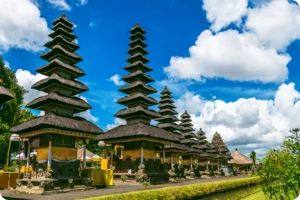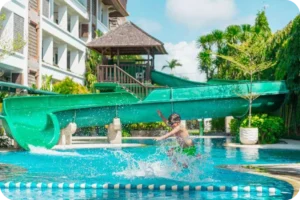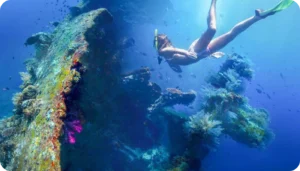Bali is a destination that captivates millions, but much of its magic lies beyond the popular spots found in guidebooks and Instagram feeds. While names like Ubud, Seminyak, and Kuta are familiar to most travelers, there’s a quieter, more authentic side of the island that often goes unnoticed. Tucked away in the highlands, hidden within jungles, and resting along untouched coastlines are the island’s true treasures—places that remain largely untouched by mass tourism.
This guide invites you to step off the beaten path and experience Bali in a way that few do. From secret waterfalls and remote temples to traditional villages and natural wonders, these underrated attractions reveal the island’s deeper soul. If you’re ready to uncover the places where beauty meets authenticity and adventure meets stillness, this is where your journey begins.
Own your COCO property in paradise with benefits for life
- +200 properties in construction
- +250 properties in full operation
- Pay 20% of your property straight from rental profit
Offbeat Bali Travel Guide to Hidden Natural and Cultural Wonders
Now that Bali’s authenticity is established beyond the usual iconic sights, it’s time to explore the places that truly set the island apart. From jungle waterfalls and hidden coastal escapes to sacred temples, time-honored villages, forgotten royal sites, and one-of-a-kind experiences rarely mentioned in guidebooks, these offbeat destinations offer a deeper, more memorable way to experience Bali.
And you may not know—others might be inspired to visit these places too, just from your own travel stories and photo guides.
Natural Wonders Off the Tourist Radar
It’s true that Bali does not fall short on natural wonders, but among its most famous landscapes are hidden gems that many travelers never reach. So if you’re one of those who love nature or would want to experience Bali’s natural beauty without the buzz, these lesser-known spots are well worth exploring.
Taman Beji Griya Waterfall
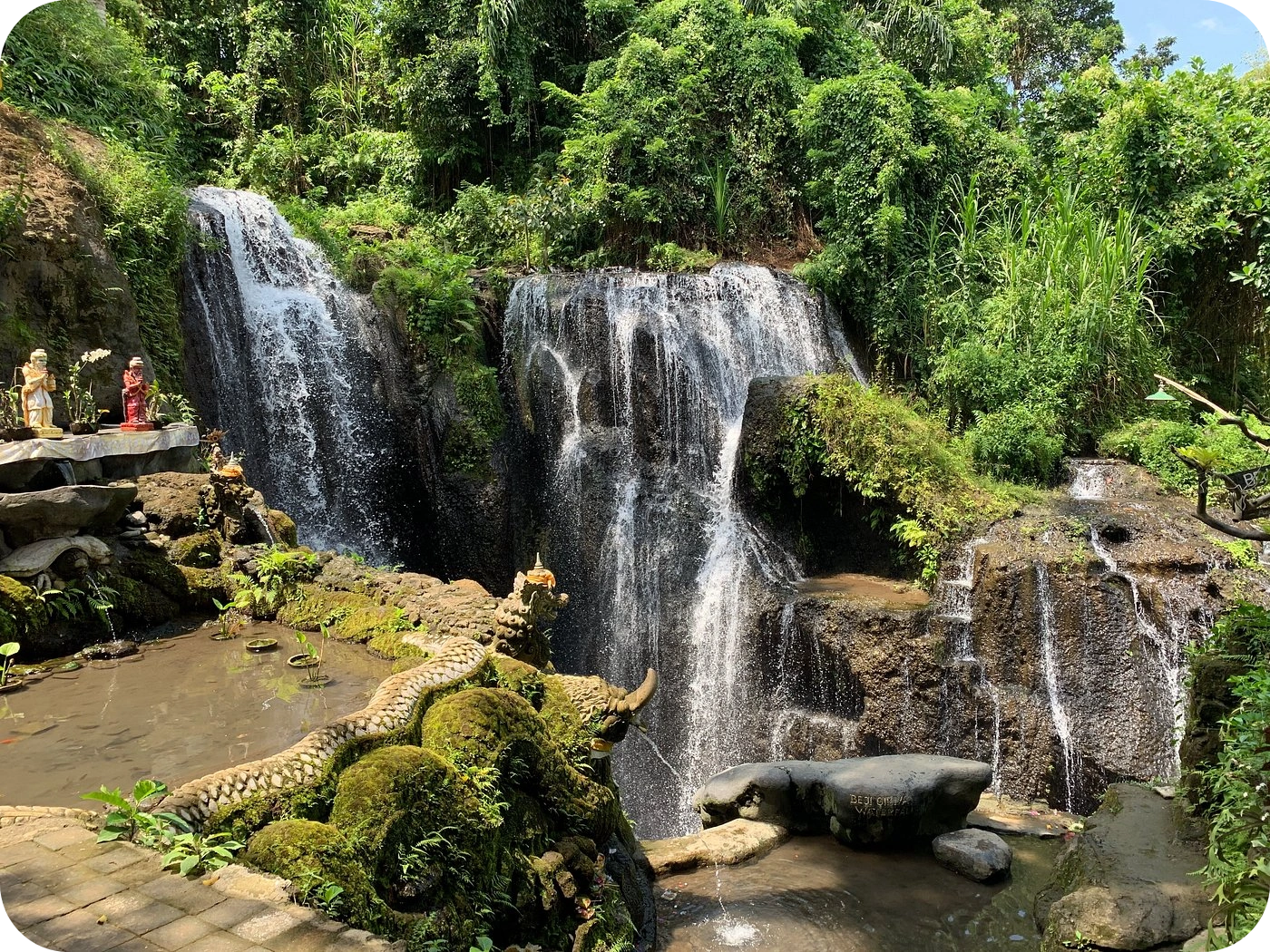
Taman Beji Griya is a sacred temple complex built over a series of cascading waterfalls, located west of Ubud near Punggul village. It holds deep spiritual significance as one of the few places in Bali where visitors can take part in Melukat, a traditional water purification ritual, similar to those performed at Pura Tirta Empul. This site, once a sanctuary of the Griya Gede Manuaba Punggul family, is adorned with ancient rock carvings, religious statues, and daily offerings, creating an atmosphere of deep reverence and tranquility. Beyond its cultural importance, the waterfall itself is a breathtaking 15-meter cascade, surrounded by lush rice fields and dense wilderness. While the entrance fee starts at IDR 100,000 ($6.00)—higher than most waterfalls—it includes a complimentary hot drink at a local warung and designated parking, making the experience both enriching and worthwhile for those seeking a blend of nature and spiritual immersion.
Located in the village of Sangeh, Taman Beji Griya Waterfall is more than just a scenic spot. It’s a sacred site where visitors can partake in traditional Balinese purification rituals, immersing themselves in the island’s spiritual practices. The waterfall, enveloped by lush greenery, offers a tranquil setting for reflection and rejuvenation.
- Location: Jl. Mawar, Punggul, Kec. Abiansemal, Kabupaten Badung, Bali 80352
- Entrance Fee: IDR 100,000 or $6.00 (includes cleansing ritual)
- Opening Hours: 8:00 AM – 6:00 PM
Tukad Cepung Waterfall
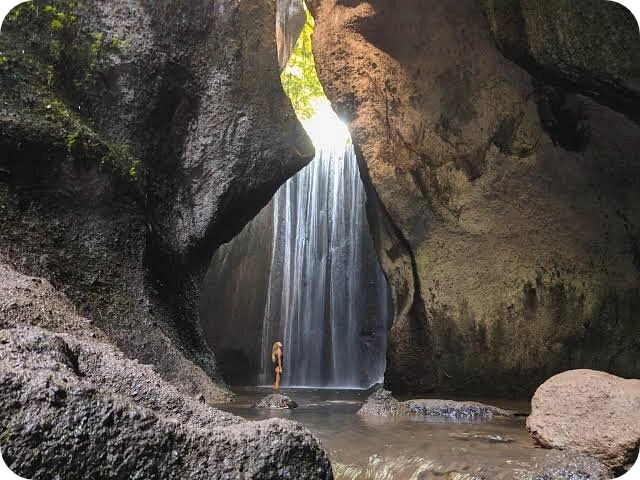
If anything hidden tickles you right in your side, then this hidden waterfall is definitely for you to go. Tukad Cepung Waterfall is a one-of-a-kind cascade tucked inside a cave-like ravine, where dramatic light rays stream through the narrow opening, creating a mystical sunbeam effect—perfect for those Instagram-worthy shots.But reaching this natural wonder isn’t just a casual stroll; you’ll need to hike through a shallow river, maneuvering over large rocks and narrow pathways, before being rewarded with an otherworldly atmosphere that feels untouched by time.
And while Tukad Cepung is the highlight, a smaller nearby waterfall offers a leafy jungle setting and a gentle natural shower for those who want a refreshing mist. However, know that swimming isn’t an option, as the water level remains only knee-deep and there are no natural pools for you to take a dip in. Despite its hidden nature, expect some crowds, especially during peak seasons, as visitors line up for the perfect shot. For the best chance at capturing the sunbeam effect, plan your visit between 9 AM and 11 AM, when the sunlight perfectly illuminates the falls.
- Location: Jalan Tembaku, Dusun Penida Kelod, Tembuku, Kabupaten Bangli, Bali- 80671, Indonesia
- Entrance Fee: IDR 15,000 ($0.90)
- Opening Hours: 7:00 AM – 6:00 PM
Bayad Waterfall
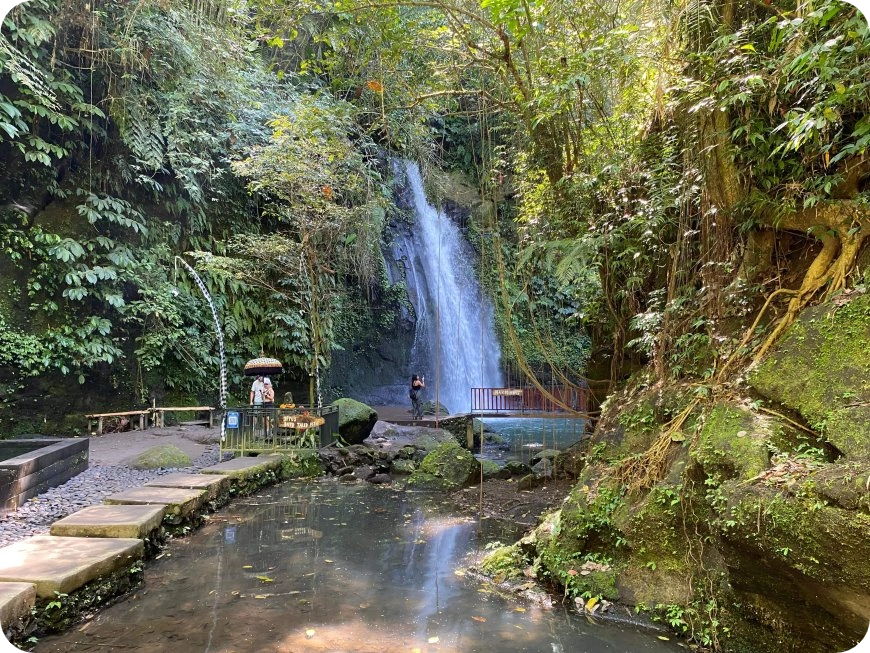
If you’re looking to experience Bali’s natural beauty without the crowds, Bayad Waterfall is a hidden gem you won’t want to miss. Located just 20 minutes from Ubud, this peaceful waterfall offers a refreshing escape into nature. The short trek to reach it winds through lush rice fields, tropical plants, and shaded stone paths that immediately set a tranquil tone. Along the way, you’ll cross a charming bridge, pass koi-filled streams, and soak in the quiet scenery that makes the journey as rewarding as the destination. Once you arrive, the gentle cascade and surrounding greenery create a calm, almost meditative atmosphere—perfect for those seeking a moment of stillness away from Bali’s busy tourist hubs.
What makes Bayad even more special is its connection to the broader eco-trail that includes Goa Maya, a nearby cave site home to Hindu statues, herbal gardens, and a traditional spice center. The entire area is ideal for a half-day exploration combining nature, culture, and soft adventure. Best of all, it remains relatively untouched by mass tourism, allowing for a more intimate and authentic experience. Visit early in the day to enjoy the soft morning light and the soothing sounds of the forest without the buzz of other visitors.
- Location: H8P2+6F8, Manik Sawang, Bayad Village, Kedisan, Kec. Tegallalang, Kabupaten Gianyar, Bali 80561
- Entrance Fee: 20,000 IDR
- Opening Hours: Daily, 8:00 AM to 5:00 PM
Invest in Bali’s #1 Lifestyle Property Brand
Discover high-yield villa investments starting at just $50,000 with average returns of 17–20%—all in one of the world’s most sought-after destinations.
Sekumpul Waterfall
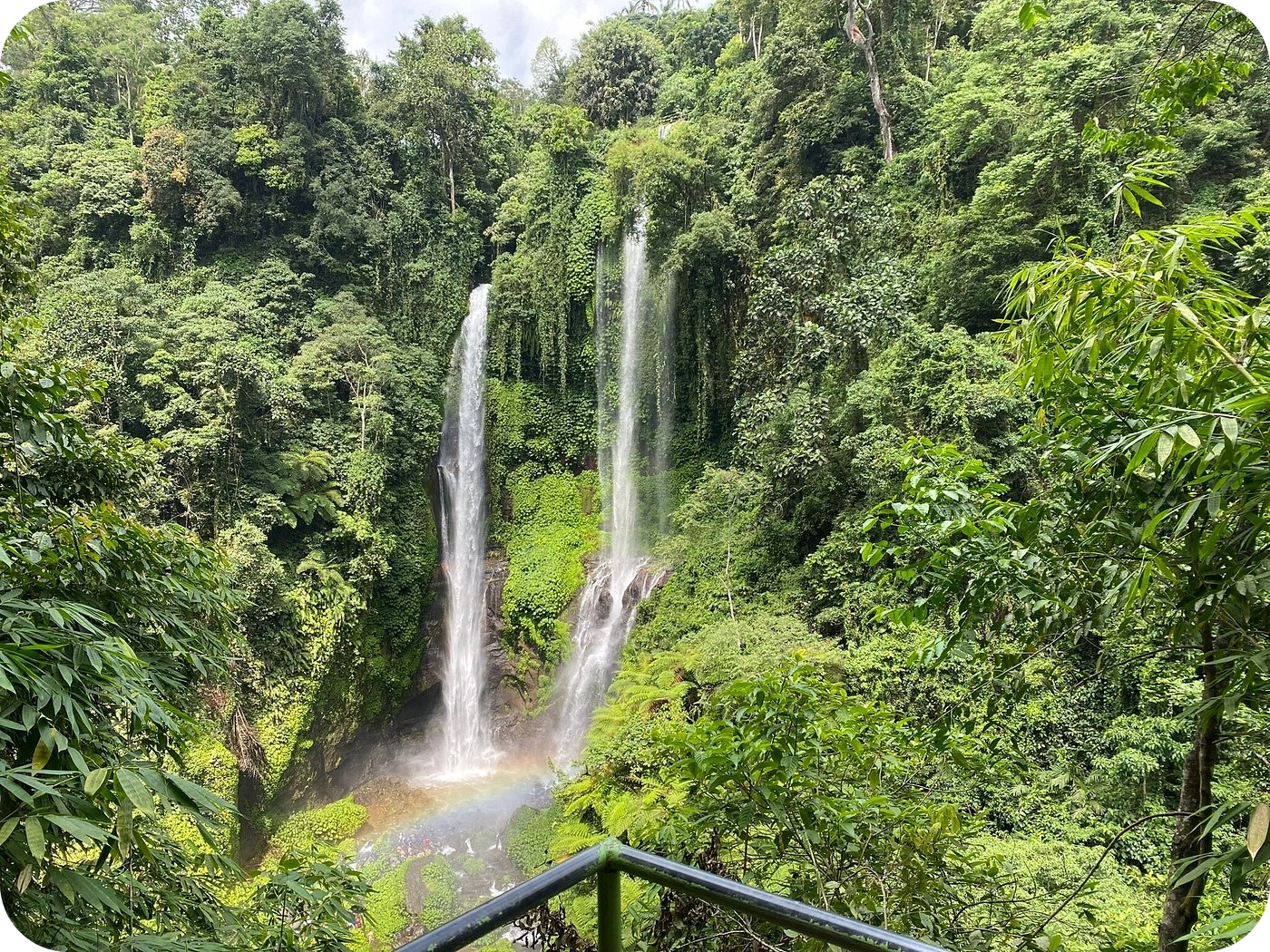
Sekumpul, meaning “collection,” is a fitting name for the seven waterfalls located in a lush jungle setting of Singaraja Regency. Among them is Bali’s tallest and most powerful cascade, standing at an impressive 80 meters, with a waist- to chest-deep natural pool at its base. From the viewpoint above, visitors can soak in the breathtaking panorama of towering falls, dense jungle, and sprawling rice terraces, making it one of the island’s most picturesque landscapes. However, reaching the waterfall requires navigating 365 steep and often slippery steps, making it a thrilling yet rewarding trek for adventure seekers. So, if you’re an adventure lover fond of crossing the extra mile for a refreshing sight, you should visit Sekumpul waterfalls.
Although the place is an open secret to tourists, Sekumpul remains refreshingly uncrowded, thanks to its remote location away from the usual tourist hotspots. So, for those looking to make the most of a Bali waterfall tour, pairing it with nearby Aling-Aling and Gitgit Waterfalls surely promises an unforgettable day of exploration and natural beauty.
- Location: Sekumpul, Sawan, Lemukih, Sawan, Kabupaten Buleleng, Bali
- Entrance Fee: IDR 20,000 ($1.25) but can go as high as IDR 125,000 ($7.65) for guided treks
- Opening Hours: 8:00 AM – 6:00 PM
Lake Tamblingan
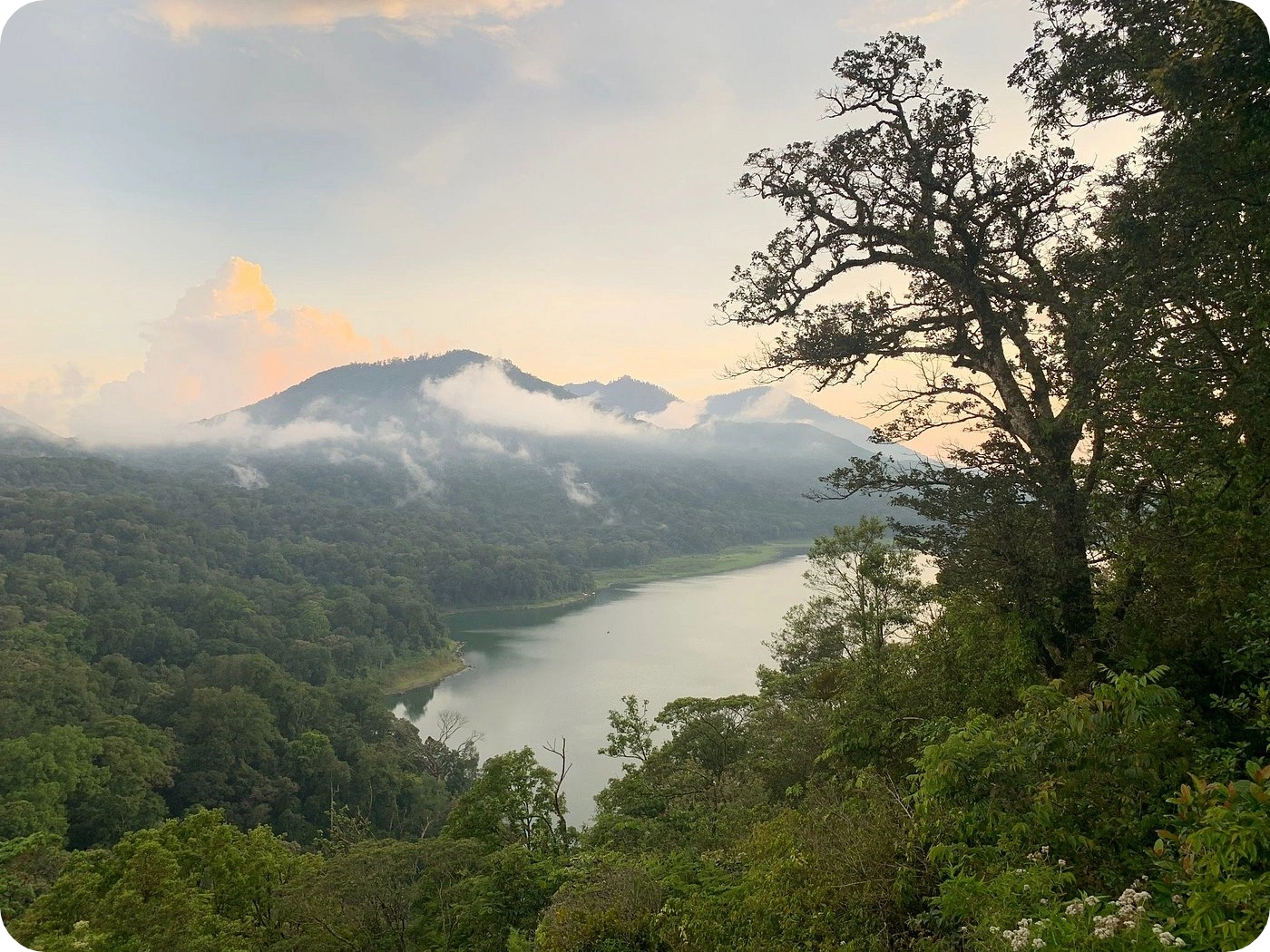
If you’re chasing Bali’s more peaceful corners, Lake Tamblingan is a soulful stop in the highlands of Munduk that deserves a spot on your list. Specifically, this caldera lake, formed within an ancient volcanic crater, is surrounded by dense rainforest and offers a tranquil atmosphere far removed from the island’s bustling tourist spots. The area is steeped in spirituality, with ancient temples like Pura Dalem Tamblingan dotting the lakeshore, reflecting the rich cultural heritage of the region. Visitors can explore the lake by traditional canoe, absorbing the serene ambiance and connecting with Bali’s spiritual roots.
For nature enthusiasts, the surrounding rainforest provides opportunities for trekking, where one can encounter diverse flora and fauna, including orchids and macaques. The lake’s elevation at approximately 1,217 meters above sea level ensures a cool climate, making it a refreshing retreat. Unlike more commercialized destinations, Lake Tamblingan remains relatively untouched, offering a peaceful environment for reflection and exploration.
- Location: Jl Danau Tamblingan, Desa Tamblingan, Sukasada, Munduk Village, Buleleng Regency, Bali 81152
- Entrance Fee: Approximately 10,000–30,000 IDR
- Opening Hours: Open 24 hours daily
Secluded Beaches and Coastal Retreats
Kelingking Beach
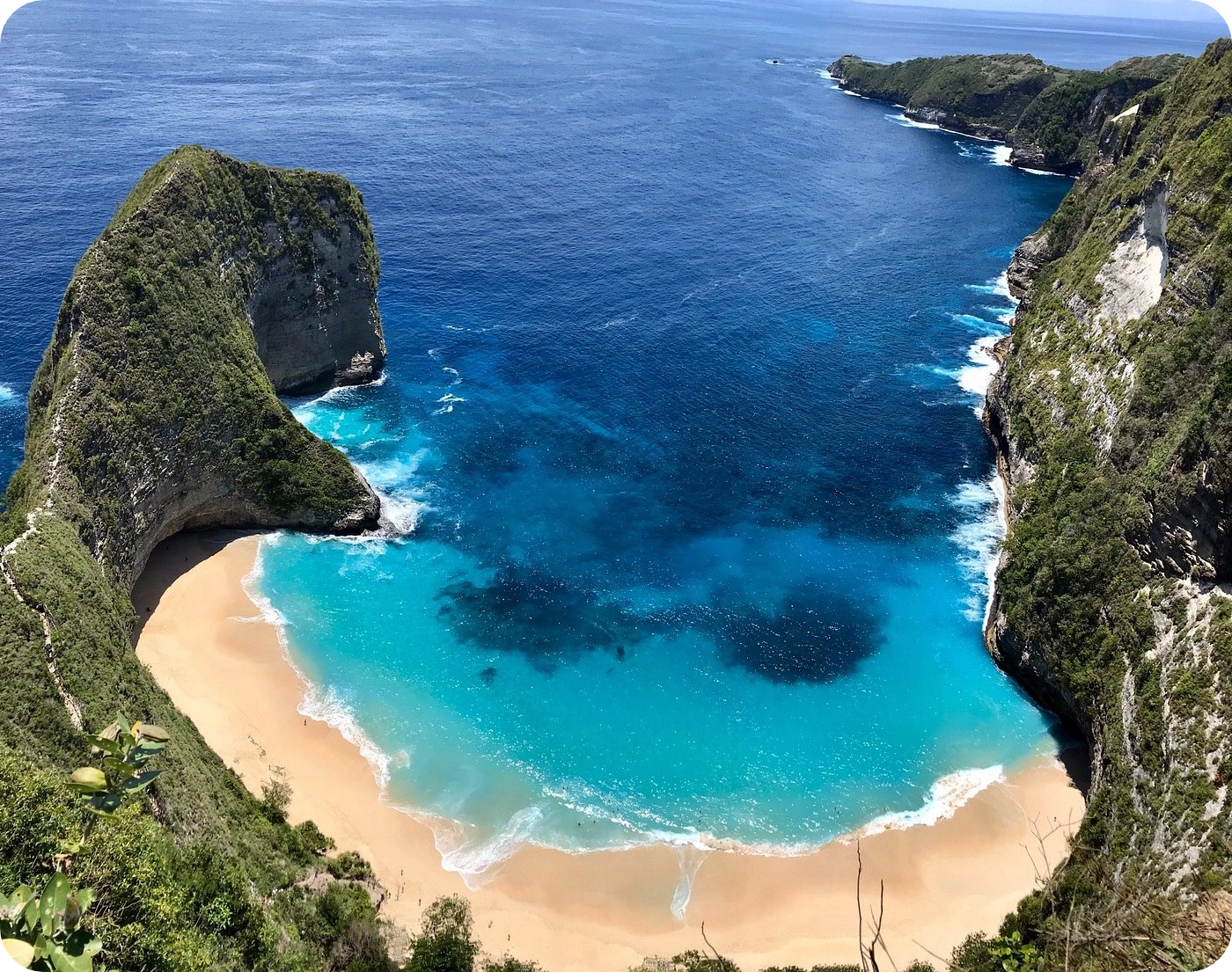
Few views in Bali can match the jaw-dropping sight of Kelingking Beach on Nusa Penida. From the dramatic cliff-top viewpoint, you’ll see a stretch of powdery white sand hugged by turquoise waters and framed by a jagged headland that uncannily resembles a T-Rex, earning it the nickname “T-Rex Beach.” It’s a visual spectacle that has become one of Bali’s most iconic Instagram shots, and for good reason.
The clifftop is where most visitors capture their stunning content, with panoramic views that offer a cinematic sweep of ocean, cliffs, and sky. The sheer drop and the scale of the landscape create a dramatic sense of depth that looks incredible in wide shots, drone captures, or portrait-style poses framed by the natural curves of the cliff. To get the best lighting, visiting around mid-morning is recommended as early shadows can obscure the detail, while midday sun tends to flatten the colors. If you’re feeling adventurous, the hike down to the beach is possible but steep and requires good shoes, balance, and caution.
- Location: Desa Bunga Mekar, Nusa Penida, Klungkung Regency, Bali 80771
- Entrance Fee: IDR 10,000 ($0.70) per person.
- Opening Hours: Open all day.
Balian Beach
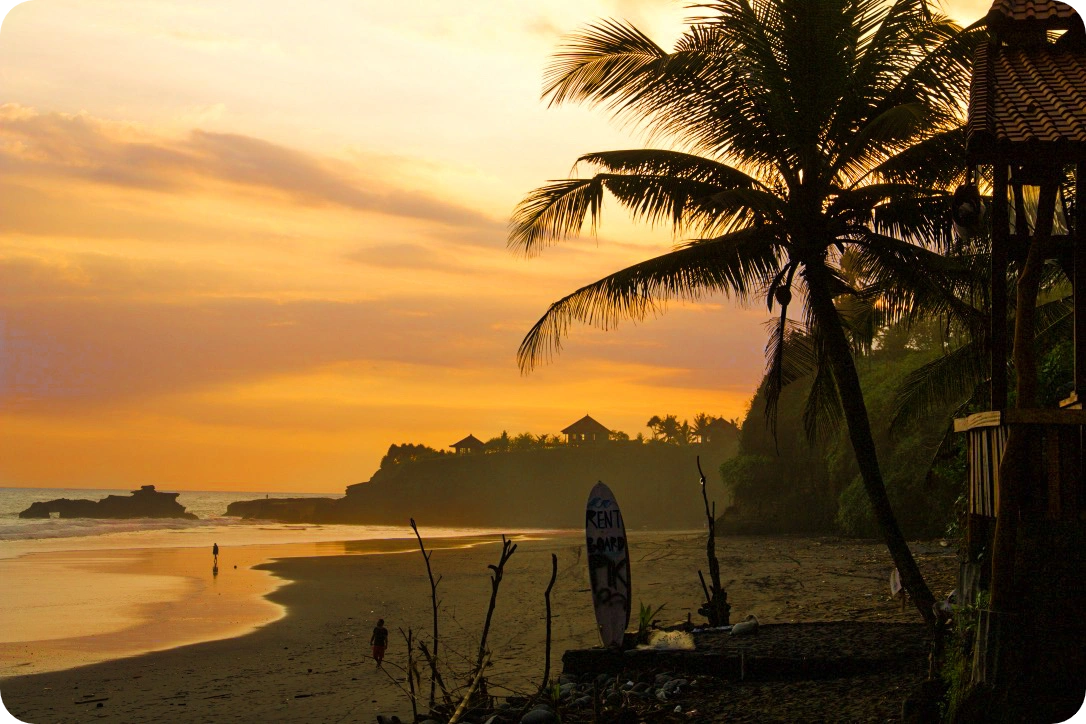
If you’re into beaches more than waterfalls and lakes, Balian Beach might just be your kind of paradise. Located about 90 minutes from Seminyak or Ubud, this quiet black-sand stretch on Bali’s western coast offers a refreshing escape from the tourist-heavy shores of Kuta or Canggu. With rice fields on one side and rugged cliffs framing the coastline, Balian has a raw, untouched charm that’s perfect for those seeking calm, space, and natural beauty without the buzz.
Though it’s popular among surfers for its consistent waves—thanks to the deep channel at the Balian River mouth—it’s not just for board riders. Yoga retreats, laid-back beach warungs, scenic coastal walks, and striking sunsets all invite you to slow down and settle into Bali’s more tranquil rhythm. Just be mindful of occasional strong currents and river-mouth wildlife. Whether you’re here to catch a wave or simply soak up the view, Balian Beach offers an authentic slice of coastal Bali that feels worlds away from the usual crowds.
- Location: Jl. Pantai Balian 83F. Br. Pengasahan. Desa Lalanlinggah, Tabanan, Bali, Bali, Indonesia, 82162
- Entrance Fee: None
- Activities: Surfing, yoga, beach walks, dining at local warungs
why investors choose
coco development group?

Passive income on full auto pilot
Profit Maximization
We do not just put your property on Airbnb hoping for a guest to book it. More than 40% of our bookings comes today through our own medias, a strong community and a digital and data driven management approach.
A Convenient and fast payment system
The investors receive net profits currency that is convenient for them. we transfer the money once every three months
No need to handle taxes
High Liquidity
Fast Payback
Oceanside villas in Bali are in High demand for daily rentals. You will earn about 5000 USD per month
Cultural and Spiritual Treasures Few Discover
Kehen Temple
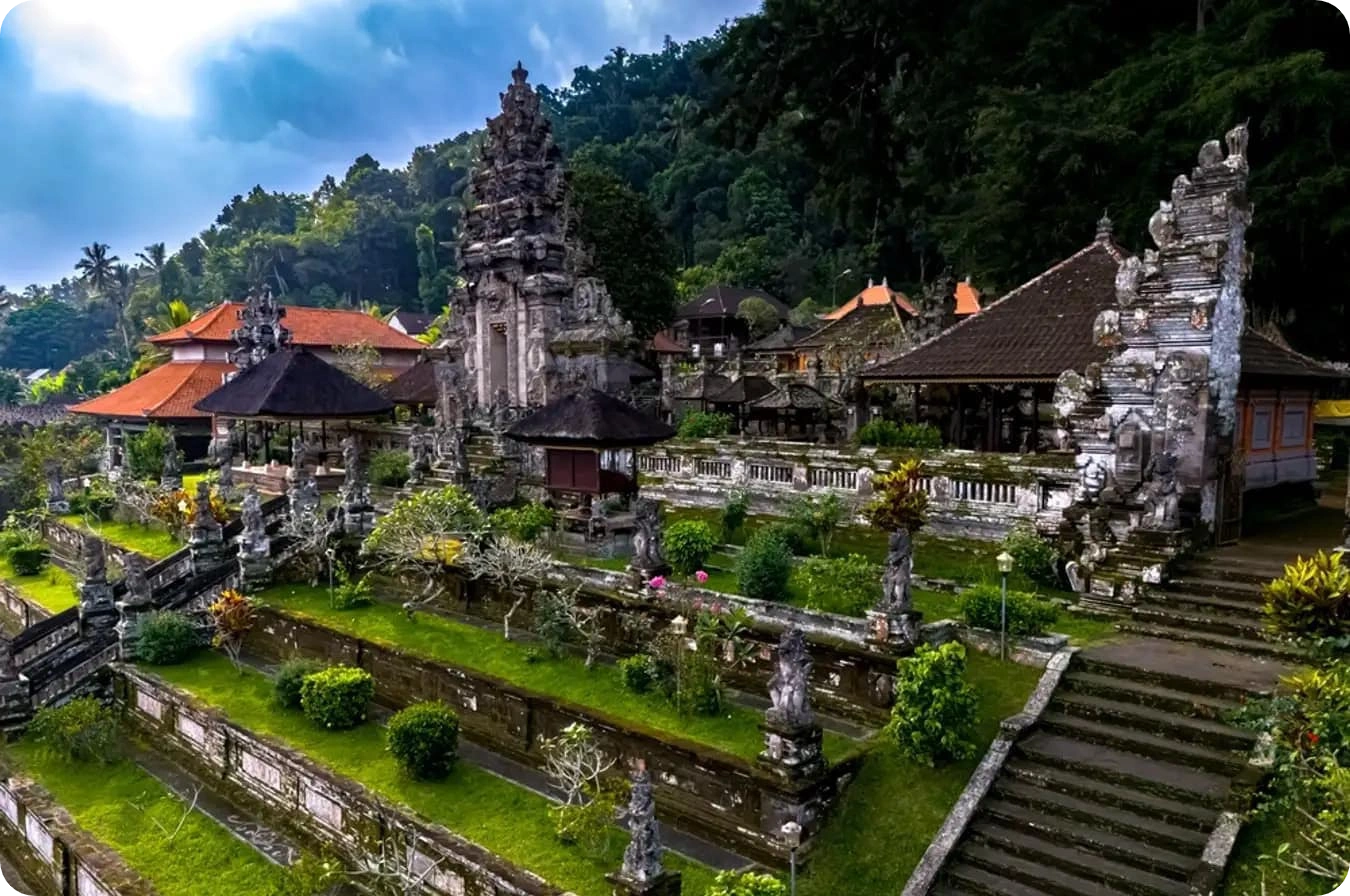
If you are after cultural experiences that go beyond the usual tourist spots, Kehen Temple in Bangli deserves a place on your list. Often referred to as the “miniature version of Besakih,” this centuries-old Hindu temple sits on a terraced hillside and is adorned with beautifully preserved stone carvings, traditional Balinese architecture, and a towering banyan tree that greets you at the gate.
Despite its historical significance, Kehen Temple remains relatively quiet, making it ideal for a peaceful and more personal experience. So, if going to Besakih Temple is out of your way or time, you may want to visit Kehen instead—though visiting both can be nice as well if you have the chance.
- Location: Jl. Sriwijaya No.8, Cempaga, Kec. Bangli, Kabupaten Bangli, Bali 80613
- Entrance Fee: Around IDR 30,000
- Opening Hours: 8:00 AM – 5:00 PM
Brahmavihara-Arama
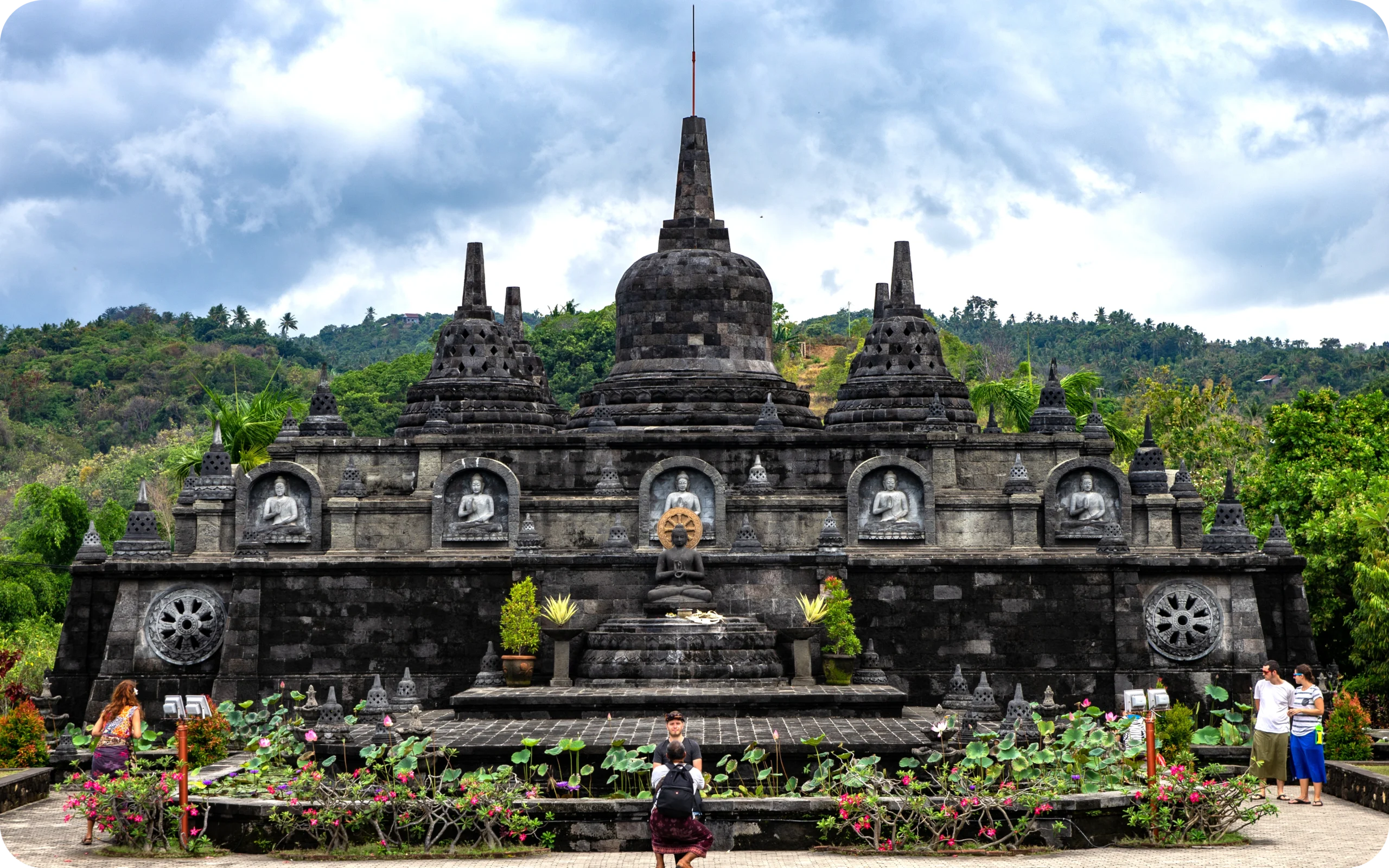
If the famous Banjar Hot Springs is on your itinerary, you might as well visit Brahmavihara-Arama, which is just a few minutes’ ride away. As Bali’s only Buddhist monastery, this serene retreat offers a unique contrast to the island’s predominantly Hindu temples. Often called “Little Borobudur,” it features a miniature replica of Java’s Borobudur Temple, nestled at the highest level of the monastery, surrounded by lush gardens and reflective ponds.
The architecture itself is a stunning fusion of Balinese design and Buddhist elements, evident in the intricate dragon sculptures that flank the grand staircase in the first courtyard. As you explore, you’ll find golden Buddha statues, impressive artwork displays, and intricately designed prayer halls, stupas, and meditation areas, all set against breathtaking views of the surrounding countryside. This hidden gem also remains relatively quiet unlike other tourist-heavy attractions, making it an ideal place for peaceful strolls and a deeper appreciation of Buddhist history. However, know that reaching the temple gate requires ascending the grand Heavenway staircase—but the climb is worth it, as the path is adorned with beautiful murals, statues, and picturesque spots depicting the life of Buddha. Plus, the reflective ponds here make for truly Instagram-worthy photos!
- Location: Banjar Dinas Tangeb, Banjar Tegeha, Kec. Banjar, Kabupaten Buleleng, Bali 81152, Indonesia
- Fee: Entrance fee costs IDR 25,000 ($1.50) per person
- Opening Hours: 8 AM to 6 PM
Goa Lawah Temple
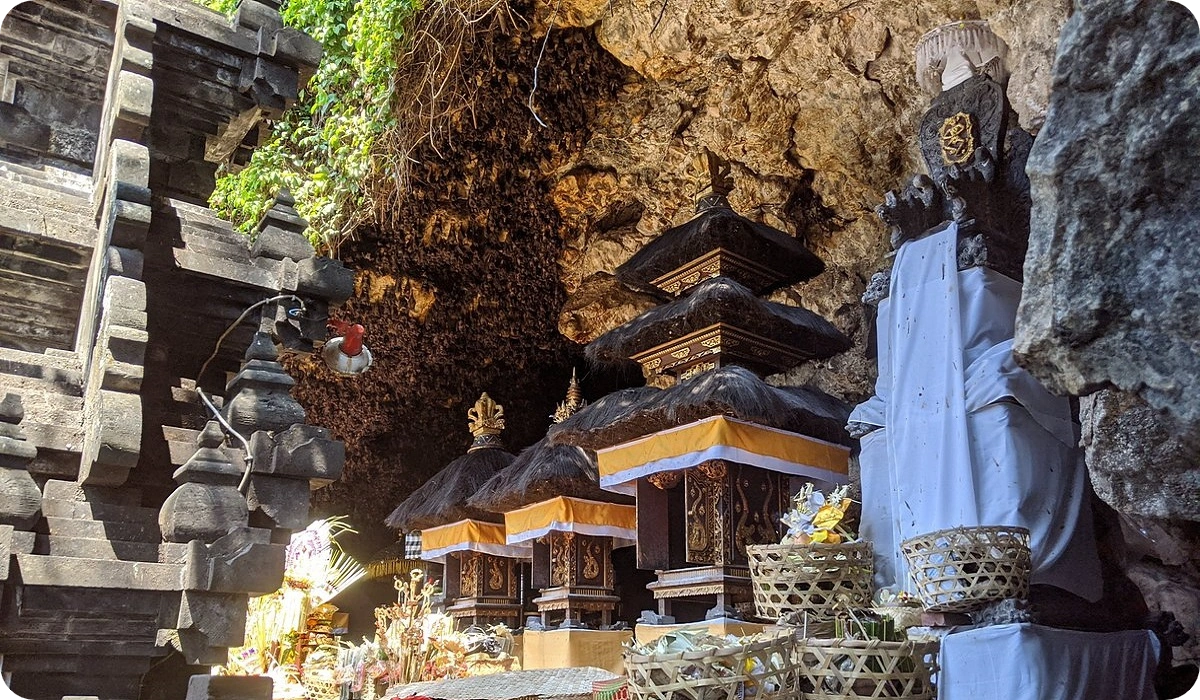
Quite unique from all other religious and sacred temples in Bali, Goa Lawah Temple is one of the few that intertwines natural elements with spiritual significance. Directly translated to “Bat Cave Temple,” Pura Goa Lawah is built around a cave inhabited by thousands of bats, making it a fascinating fusion of wildlife and worship. Located in Klungkung, this centuries-old temple plays an important role in Balinese Hinduism and is frequently used for purification ceremonies and other rituals.
Though a bit farther from central areas like Uluwatu, Goa Lawah is well worth the visit if you’re exploring Bali’s spiritual landmarks. The temple’s dramatic setting—tucked between sea and mountains—adds a mystical touch, offering a serene yet slightly eerie atmosphere that sets it apart from other temples on the island.
- Location: Jl. Raya Goa Lawah, Pesinggahan, Kec. Dawan, Kabupaten Klungkung, Bali 80761
- Entrance Fee: IDR 15,000 ($1 USD).
- Opening Hours: 8:00 AM – 6:00 PM
Villages and Regions That Show Bali’s Untouched Side
Pemuteran
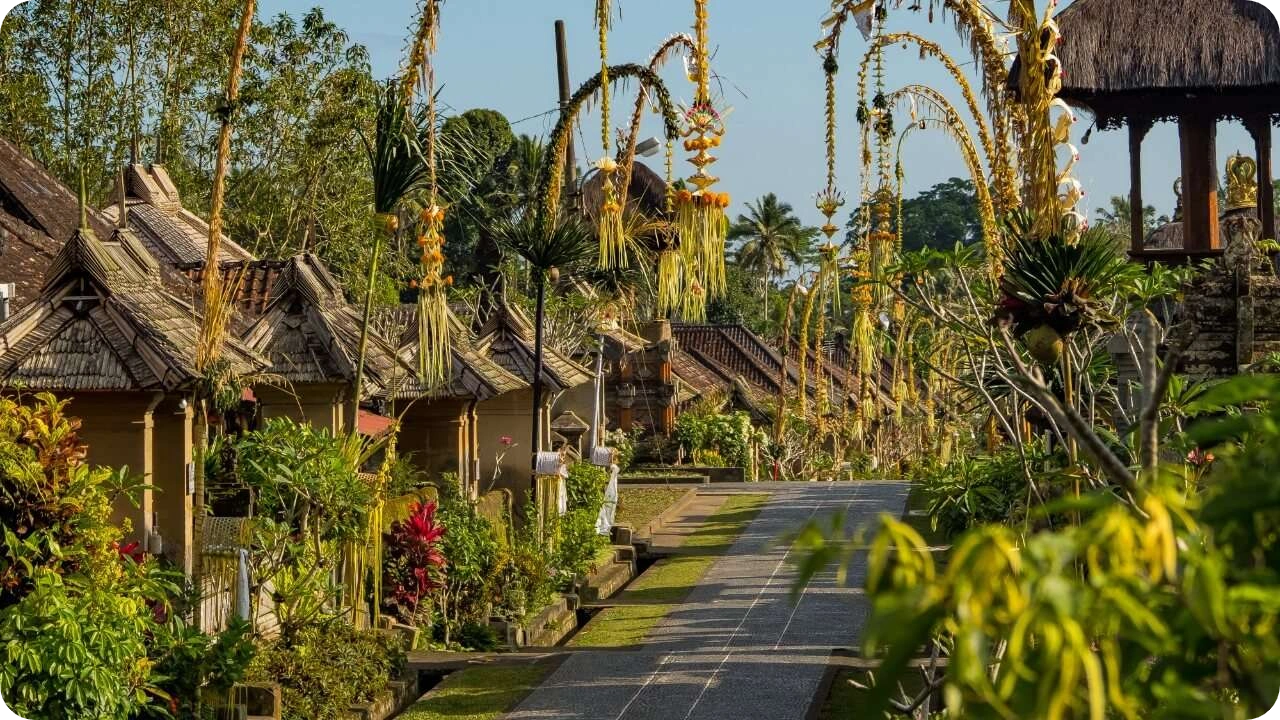
Now, if you’re more of a social type of person, you may come visit villages in Bali—and one of the must-visits would be Pemuteran. Located on the island’s northwest coast, this tranquil fishing village offers a slower pace of life and a strong sense of local community. Unlike Bali’s more commercial beach towns, Pemuteran is rooted in sustainability and tradition, making it ideal for travelers seeking meaningful cultural connections.
It’s also a paradise for underwater lovers, thanks to the Bio-Rock coral reef restoration project (the largest of its kind in the world!). The calm, clear waters make for excellent snorkeling and diving conditions, where you can swim alongside vibrant marine life while supporting marine conservation. With fewer crowds, beautiful views, and friendly locals, Pemuteran provides a refreshing blend of nature, culture, and community spirit.
- Location: Jalan Raya Seririt – Gilimanuk, Pemuteran Village, North-West Bali., Pemuteran, Bali, Bali, Indonesia, 81115
- Entrance Fee: IDR 45,000 ($2.75 USD).
- Opening Hours: 8:00 AM – 6:00 PM
Pay 25% of Your Property Straight From Rental Profit
Reduce the financial burden. Use your own villa’s rental income to pay down your investment cost for optimal cash flow and long-term returns.
Tenganan
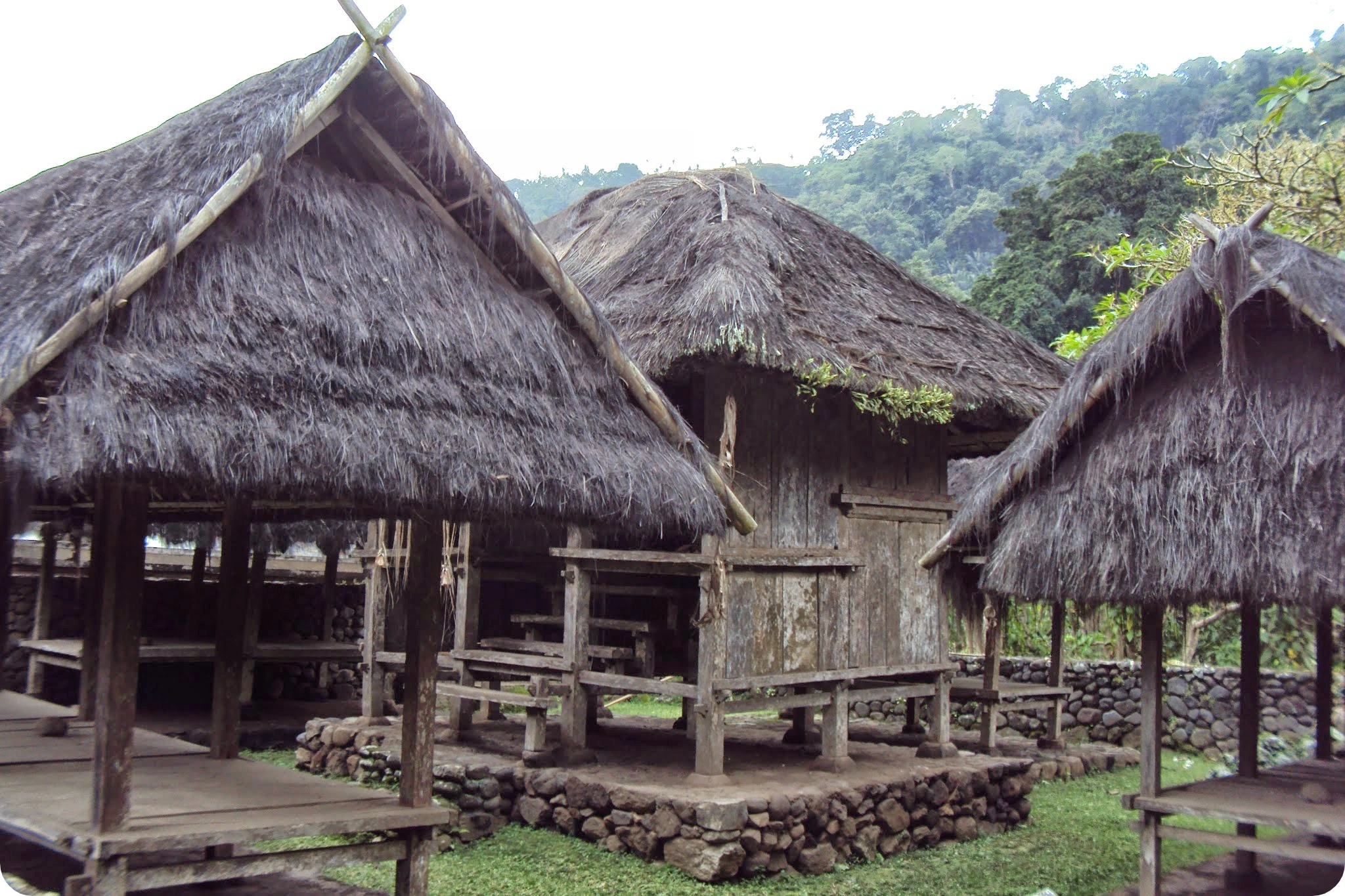
Hidden in the hills of Karangasem, Tenganan Pegringsingan is one of Bali’s oldest and most culturally intact traditional villages. It is home to the Bali Aga, the island’s original inhabitants, who have preserved their ancient customs, architecture, and rituals for centuries. The village offers a rare and authentic window into Bali’s pre-Hindu and pre-Majapahit roots.
If going back in time gives you a sense of nostalgia or a sentimental pull, Tenganan brings that feeling to life. The village layout follows age-old principles of harmony, with long rows of traditional homes and communal areas that reflect its structured way of life, unique to that of the whole Bali. Residents continue to follow strict customs, including marrying within the community, and even speak a distinct dialect not heard anywhere else on the island.
Beyond its cultural and historical value, Tenganan is also known for its rare and sacred double ikat weaving technique. The resulting textile, called Geringsing, is believed to offer spiritual protection and takes years to create. Alongside this, the village is also a center for palm-leaf carving and basket weaving, with skilled artisans passing down their craftsmanship through generations, and where visitors can observe and sometimes participate, gaining a deeper appreciation for the craftsmanship and cultural significance behind each piece.
- Location: Tenganan, Kec. Manggis, Kabupaten Karangasem, Bali 80871
- Entrance Fee: Around IDR 30,000 ($1.85)
- Opening Hours: 8:00 AM – 5:00 PM
Penglipuran Village
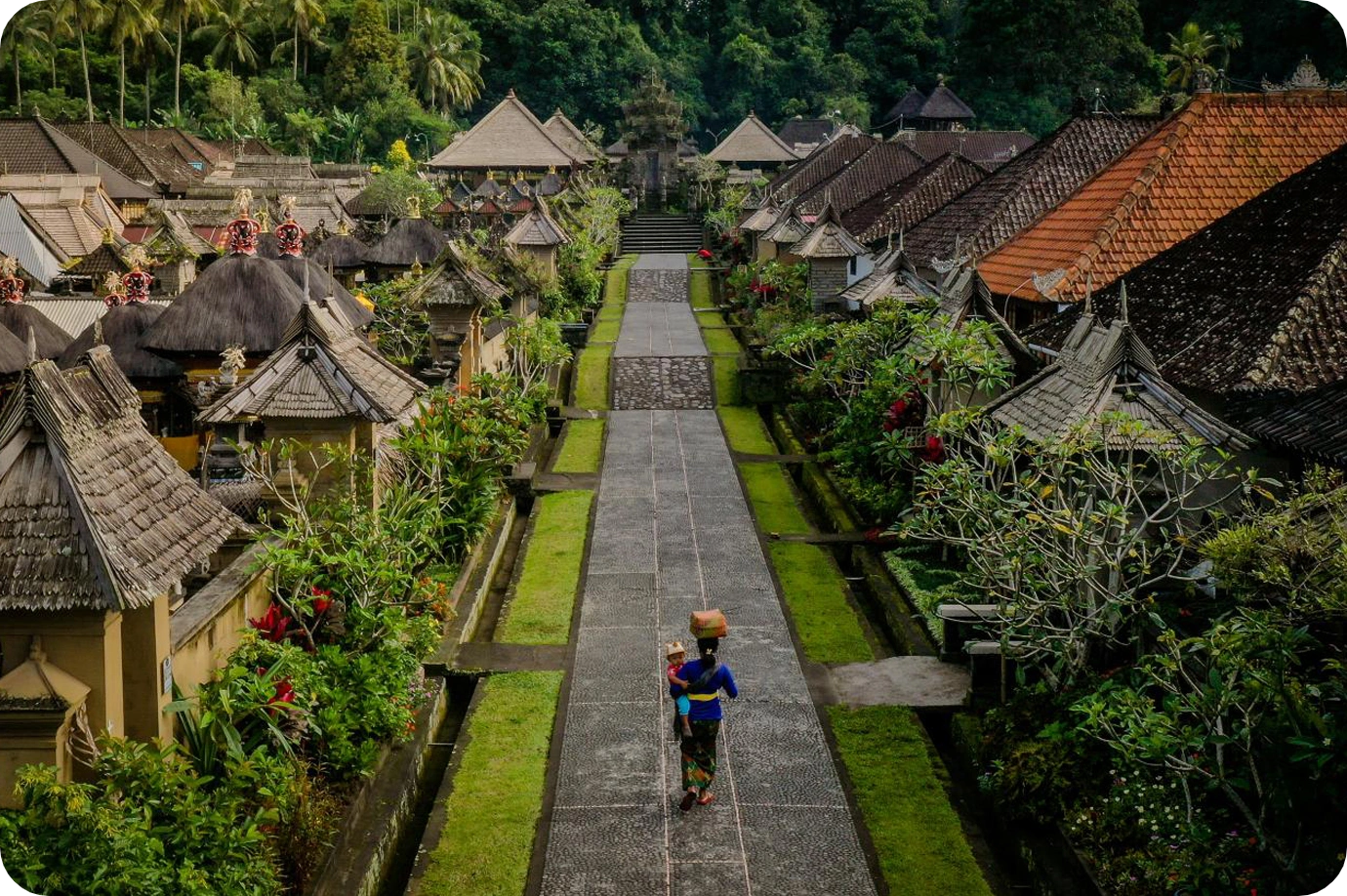
Another example of community-driven preservation in Bali is Penglipuran Village, nestled in the cool highlands of Bangli Regency. Celebrated for its exceptional cleanliness and harmony, this traditional village is designed around Tri Hita Karana, the Balinese philosophy that emphasizes balance between humans, nature, and the divine. Every household compound follows a uniform architectural layout featuring stone-paved walkways, manicured gardens, and ornately carved gates—creating an atmosphere of peace and order that reflects centuries-old values. One of the village’s most distinctive rules is the absence of motor vehicles within its center; cars and motorbikes are prohibited to preserve the quiet ambiance and reduce pollution.
Penglipuran has gained international recognition for its efforts in maintaining local traditions while embracing sustainable tourism. It is often listed among the cleanest villages in the world and has received multiple awards for environmental efforts. Unlike more commercialized destinations, tourism here is carefully managed by the local community, with entrance fees and sales from handmade crafts reinvested into the village upkeep. So if you ever decide to go, strolling through the serene lanes, sipping traditional loloh cemcem (herbal drink), and observing the daily use of bamboo in both homes and crafts surely offer an immersive glimpse into a way of life that continues to thrive in harmony with nature.
- Location: Jl. Penglipuran, Kubu, Kec. Bangli, Kabupaten Bangli, Bali 80611
- Entrance Fee: IDR 25,000 (~$1.60)
- Opening Hours: 8:00 AM – 6:30 PM
Pinggan Village & Viewpoint
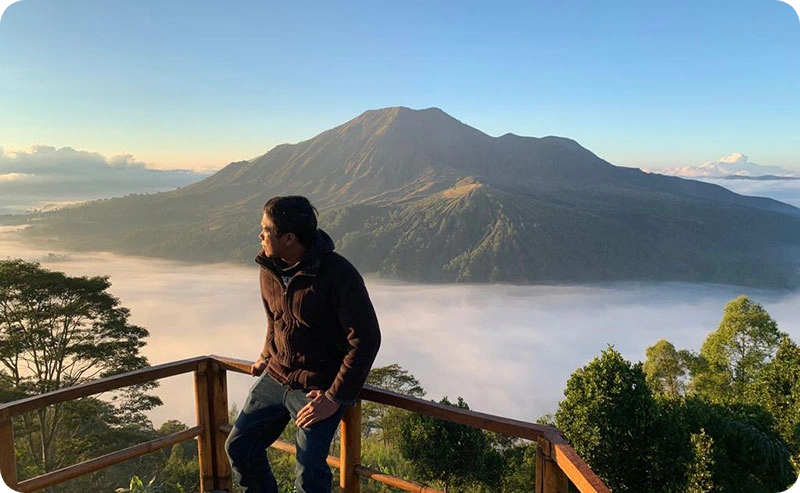
Though not as culturally enriching as the other villages mentioned in this list, Pinggan Village captivates travelers with its breathtaking natural setting rather than traditional customs. Nestled in the highlands of Kintamani at around 1,300 meters above sea level, this quiet village is best known for its surreal sunrise views and dramatic mountain backdrop.
One of its most striking tourist-pulling points is its unique location, which reveals a panoramic sweep of Mount Batur and Lake Batur, often framed by morning mist and golden light. Several popular vantage points, including the Pohon Cinta viewpoint, also offer postcard-perfect scenes that have made the area a favorite among photographers and sunrise seekers. And the best part: despite its scenic appeal, Pinggan remains relatively undeveloped and peaceful, giving visitors a tranquil space to enjoy nature, breathe cool mountain air, and take in one of Bali’s most photogenic landscapes.
- Location: Pinggan Village, Kintamani, Bangli Regency, Bali 80652
- Entrance Fee: None for general access; village tours may charge IDR 50,000 ($3.05 USD) per person
- Opening Hours: Sunrise tours usually start at 3:30 AM; village tours ends at 6:00 PM
Construction you can trust
We handle all the details – no hassle for you.

5 Years full warranty

20+ Finished developments in Bali by our team

25+ Years of shared experience
Forgotten Palaces and Architectural Oddities
Abandoned Taman Festival
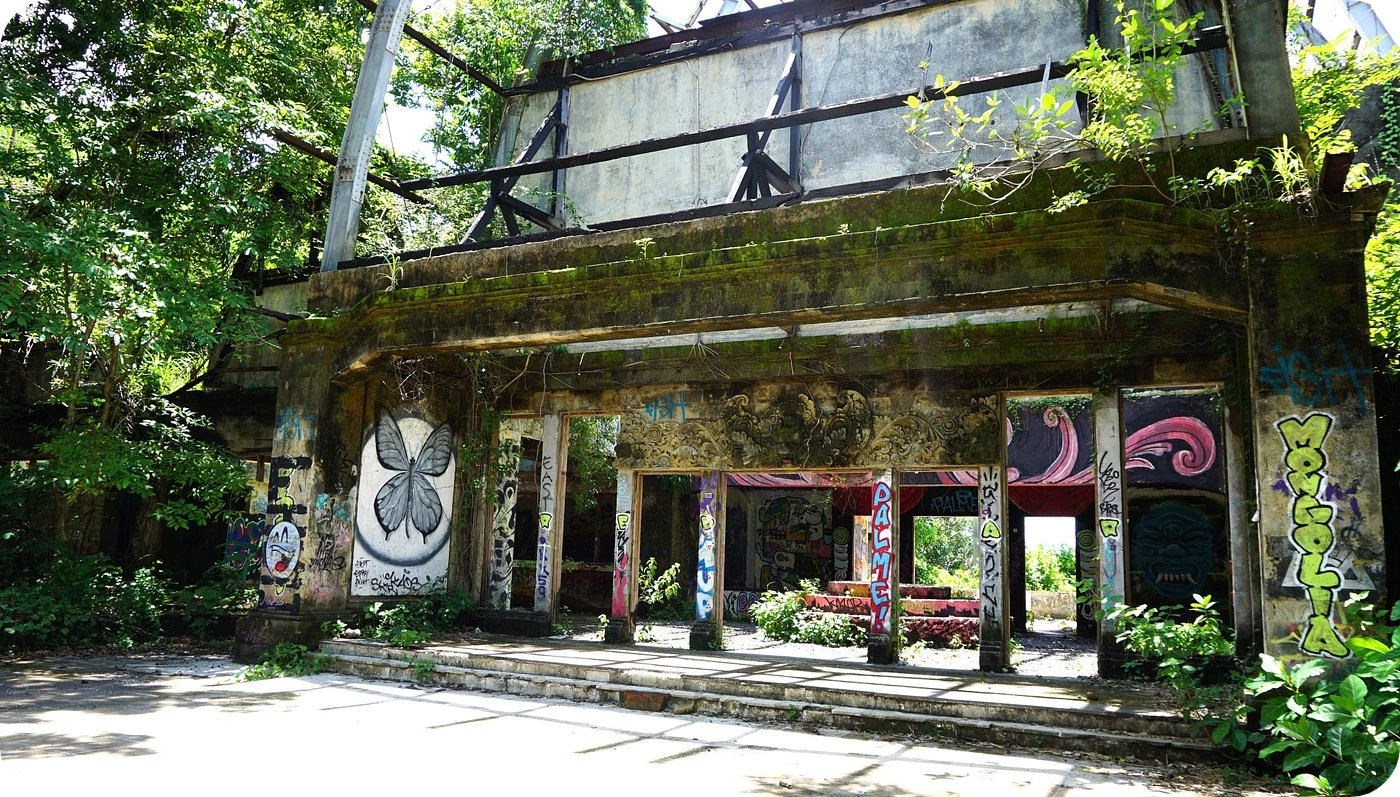
For those who love a little mystery and adventure, the Taman Festival Ruins is a unique and eerie attraction. Once envisioned as Bali’s biggest theme park, this abandoned site now stands as a crumbling yet fascinating relic, overgrown with vines and graffiti-covered structures.
Located just a short drive north of Sanur, the ruins have an almost post-apocalyptic feel, making them a great place for older kids and teenagers who love exploration and photography. While some areas may look spooky, the abandoned theaters, fake volcanoes, and broken-down rides give visitors a glimpse into what could have been Bali’s Disneyland. Just be sure to wear comfortable shoes, as the site is large and requires some walking through overgrown paths.
- Location: Jalan Padanggalak No.3, Kesiman, Denpasar, Bali 80237
- Entrance Fee: IDR 20,000 ($1.25) for DIY travelers; tours may charge more
- Opening Hours: Open 24/7
Klungkung Palace
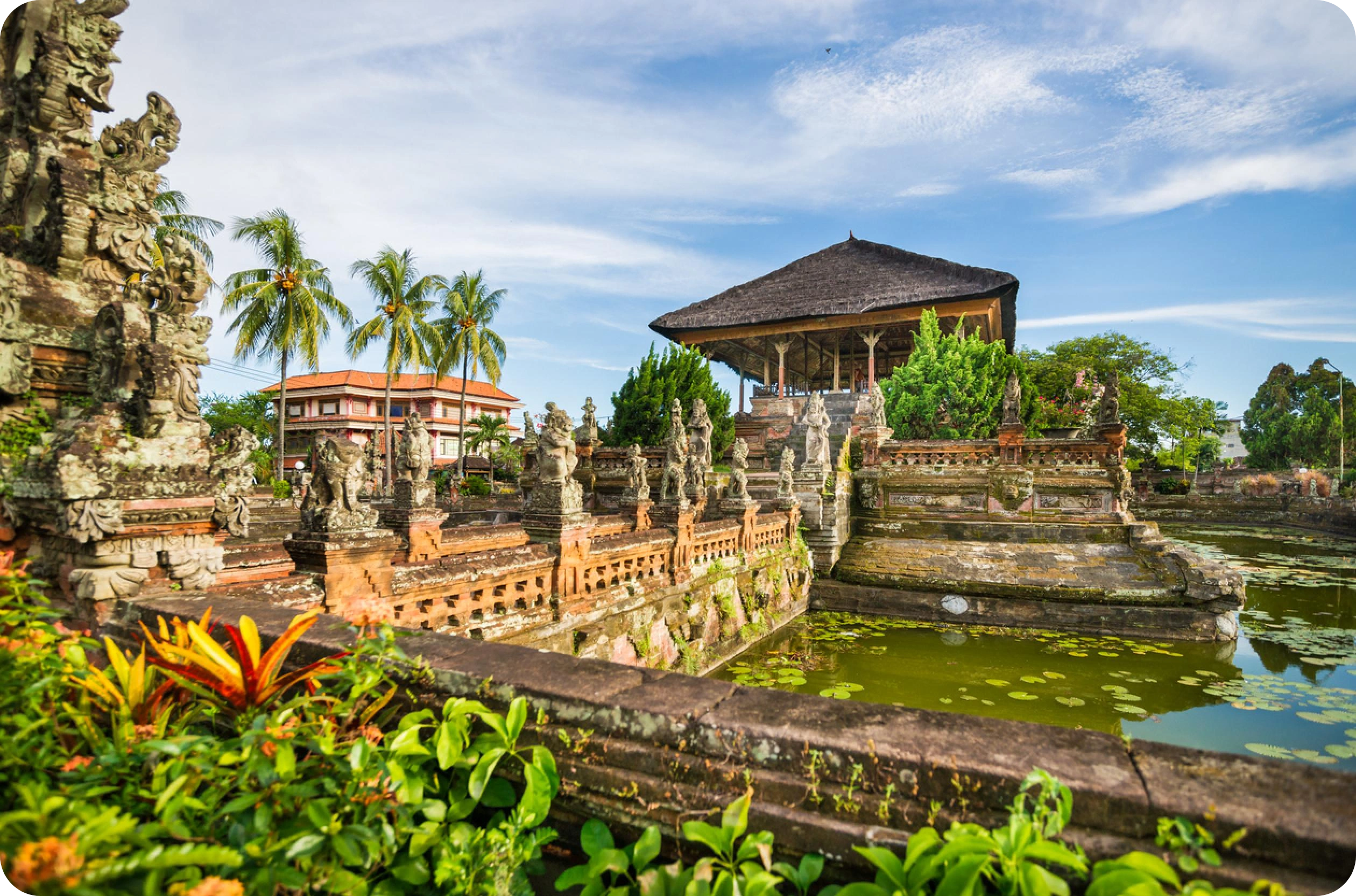
Another “forgotten” place that holds deep cultural, political, historical, and spiritual significance is Klungkung Palace, or Puri Agung Semarapura, nestled in East Bali.
While it may not appear much in many modern travel itineraries, this former royal court offers a powerful glimpse into Bali’s pre-colonial past. Once the seat of the Karangasem kingdom, this palace complex blends Balinese, Chinese, and European architectural influences, reflecting the multicultural exchanges that shaped the region. Built in the 17th century, its most iconic structure is the Kerta Gosa Pavilion, where justice was once delivered beneath elaborately painted ceilings. These Kamasan-style murals illustrate scenes from Hindu epics like the Mahabharata, used to teach moral lessons to those awaiting judgment.
And while much of the original complex was destroyed during the Dutch conquest in 1908, what’s left behind still carries the weight of Bali’s royal legacy. That said, walking through the grounds today, you can almost feel the echoes of ceremony and power that once filled this quiet yet dignified seat of the Klungkung Kingdom.
- Location: Klungkung Royal Palace, JL. Diponegoro, Semarapura Kangin, Klungkung Regency, Bali 80751
- Entrance Fee: IDR 50,000 ($3.05)
- Opening Hours: 10:00 AM – 5:00 PM
One-of-a-Kind Experiences You Won’t Find in Guidebooks
Beji Guwang Hidden Canyon
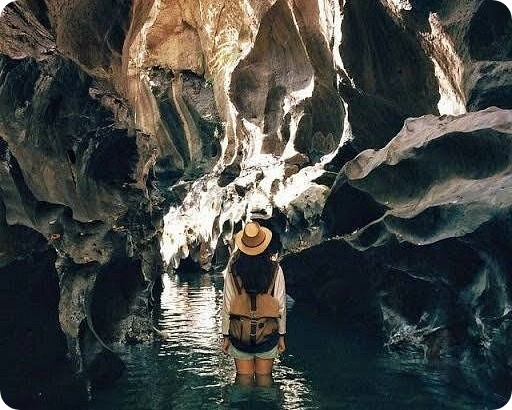
If you’re more of an adventurer, Beji Guwang Hidden Canyon in Guwang Village, Gianyar offers a thrilling escape into Bali’s geological wonders. Carved over millennia by the Oos River, this dramatic gorge features narrow passages, sculpted cliffs, and rock formations that reveal layers of Bali’s volcanic history.
Accessing the canyon requires climbing across boulders, wading through waist‑deep water, and navigating slippery terrain—making guided tours not only recommended but essential for safety. Along the journey, guides can also share the canyon’s cultural significance tied to nearby temples and water purification rituals, while the return trek through rice paddies toward distant views of Mount Batur and Mount Agung completes a nature‑meets‑culture adventure unlike any other.
- Location: Banjar Wangbung, Guwang Village, Sukawati, Gianyar Regency, Bali
- Typical Tour Duration: ~800 m canyon trek plus rice‑field return, approx. 2 hours total
- Entrance / Tour Fee: Around IDr 245,000–325,000 (USD 15–20) per person (includes guide, safety gear, towels, lunch, showers)
- Best Time to Visit: Secure a morning slot; avoid rainy season when water levels and currents become hazardous
Underwater Buddha (Ceningan/Nusa Penida)
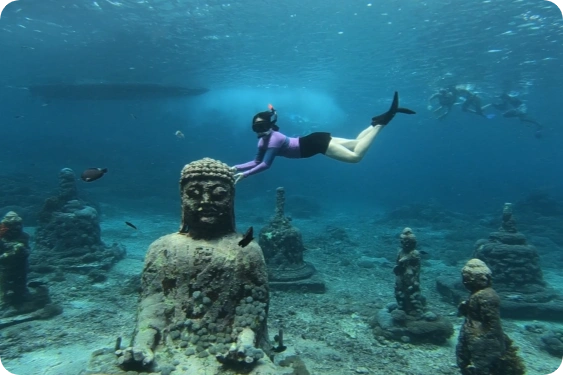
If you’re a diver or snorkeler and equally fascinated by spiritual and historical sites beneath the surface, the Underwater Buddha off Nusa Ceningan offers a rare blend of art, culture, and marine conservation. This submerged garden near the Ceningan Channel features a three-meter-tall Buddha statue surrounded by bell-shaped stupas, all deliberately placed to form an artificial reef. Visible at depths of around five meters, the installation now supports coral growth and teems with tropical fish, creating a tranquil underwater sanctuary. But note that the Underwater Buddha is only accessible through guided snorkeling tours from Nusa Penida or Ceningan for safety and sustainability purposes.
Overall, it delivers both visual impact and ecological purpose, offering a peaceful, meditative experience that merges culture and conservation beneath the waves, though strong currents mean extra care is needed and an experienced boat guide is a must.
- Location: North end of Nusa Ceningan, near the mouth of the Ceningan Channel
- Depth: Approximately 5 m (~15 ft), ideal for snorkeling without scuba gear
- Tour Access: Available via half-day snorkeling excursions from Nusa Penida or Ceningan (~IDR 200,000)
Maximize Your ROI With Data-Driven Management
Benefit from our advanced marketing channels, strong community presence, and direct bookings that outperform standard Airbnb listings.
Jemeluk Bay Underwater Temple
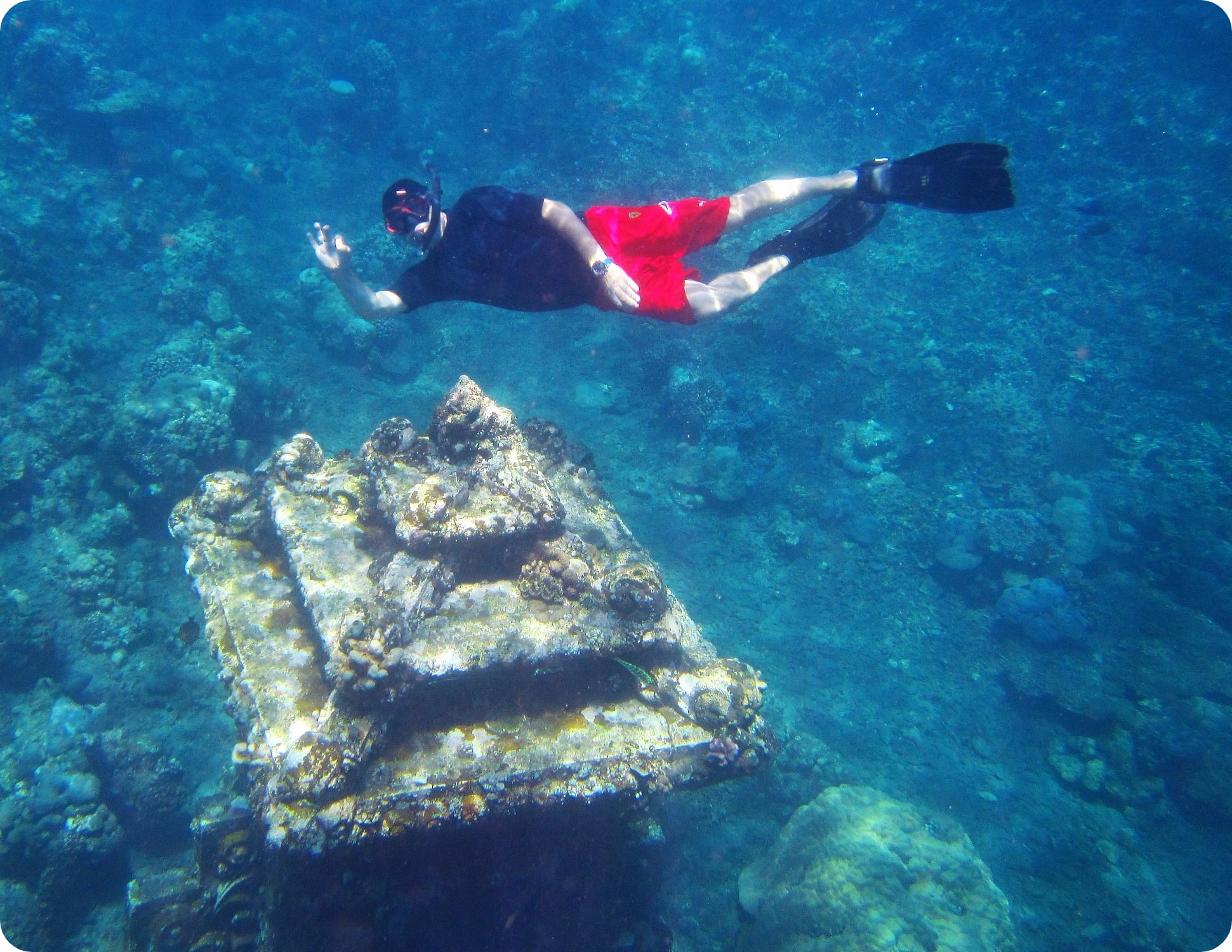
Quite similar to the Underwater Buddha in concept, the Jemeluk Bay Underwater Temple offers an extraordinary blend of art and marine conservation just off the coast of Amed. Located about 50 meters from shore and marked by buoys, this submerged site features Balinese-themed statues, apsara figures, treasure chests, and a giant baby head placed on the sea floor as part of a reef restoration initiative. The water depth ranges from 3 to 12 meters, with excellent visibility and calm conditions that make it perfect for snorkeling or shallow diving. Teeming with vibrant marine life like angelfish, blue starfish, and turtles, the site is beginner-friendly and ideal for first-time snorkelers or divers. Its peaceful setting and artistic elements create a rewarding underwater experience that combines visual intrigue with ecological significance.
- Location: Jemeluk Bay, Amed, Karangasem Regency, East Bali
- Entrance Fee: None noted; snorkeling gear rental available locally
- Opening Hours: None noted but it is better during the day for safety purposes; avoid rainy days
Green Village & Bamboo Architecture
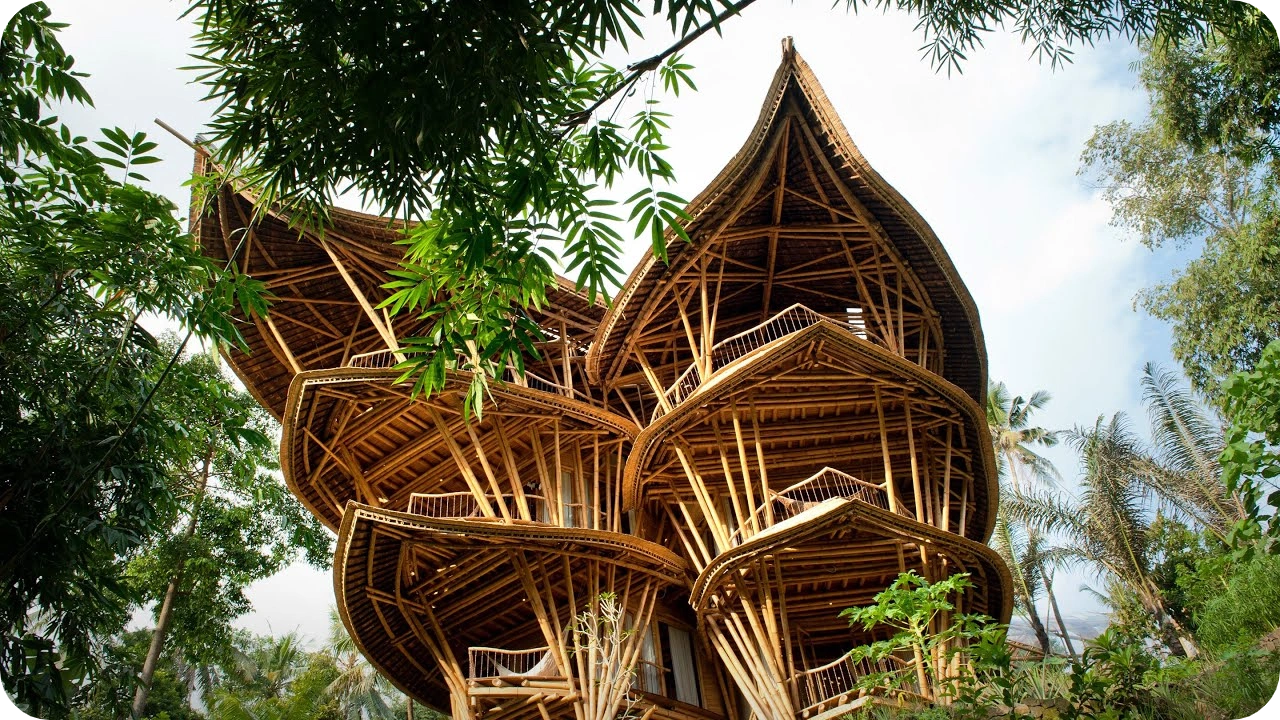
If you’re more on the nature and greenery side of things rather than drawn to the ocean and waters, Green Village is a remarkable destination located along the Ayung River near Ubud. This riverside community features a collection of uniquely designed bamboo homes and buildings, all constructed and handcrafted by the IBUKU design team using sustainably sourced bamboo treated with natural boron and built without metal fasteners to blend with the river valley’s contours.. Each structure is handcrafted with local bamboo, designed to follow the natural contours of the landscape, and built without the use of concrete or steel.
Visitors can take guided walking tours to explore these architectural masterpieces, learn about bamboo craftsmanship, and understand how the village integrates eco-living with aesthetic innovation. The homes highlight open-air layouts, natural ventilation, and artistic detailing that blend seamlessly into the jungle environment, offering a rare look into sustainable luxury living.
Visitors can book tours through Green School Bali or Ibuku to learn about sustainable architecture and innovation. These tours offer an insightful look into Bali’s role in pioneering eco-conscious design.
- Location: Sibang Gede, Abiansemal, along Ayung River, ~25 minutes from Ubud
- Tour Cost: Approx. IDR 195,000 per adult (includes guided walk, house visits, refreshments)
- Access: By reservation only, tours available weekdays via Green Village or Bamboo Pure teams
Bali Botanic Gardens
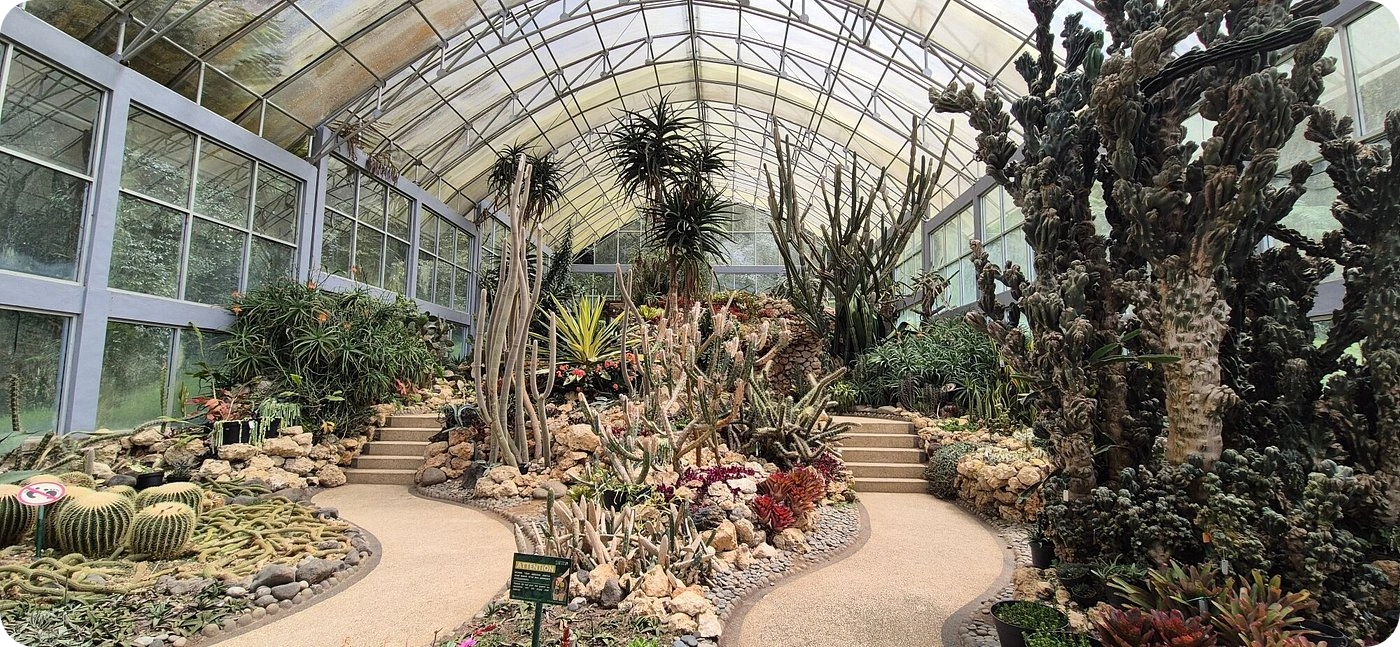
Another green and sustainability-focused hidden gem in Bali is Bali Botanic Garden, situated in the misty uplands of Bedugul around 1,250–1,450 meters above sea level. Spanning 157.5 hectares, it is Indonesia’s largest botanical garden and home to over 21,000 living specimens across 2,400 plant species, including rare orchids, begonias, ferns, cacti, and traditional medicinal flora. Visitors can enjoy themed sections such as the orchid conservatory, fern garden, and bamboo grove, while taking in panoramic views of Lake Bratan. The site also integrates conservation and education through its herbarium and research facilities. Nestled in the cool highlands, the garden offers both recreation activities—like a treetop adventure circuit—and a peaceful retreat into Bali’s natural heritage.
- Location: Candikuning Village, Bedugul, Tabanan Regency, Bali
- Entrance Fee: Around IDR 30,000 per person; vehicle charges apply as well (IDR 15–20k)
- Opening Hours: Daily 08:00 AM to 06:00 PM (last entry around 05:30 PM)
Lahangan Sweet
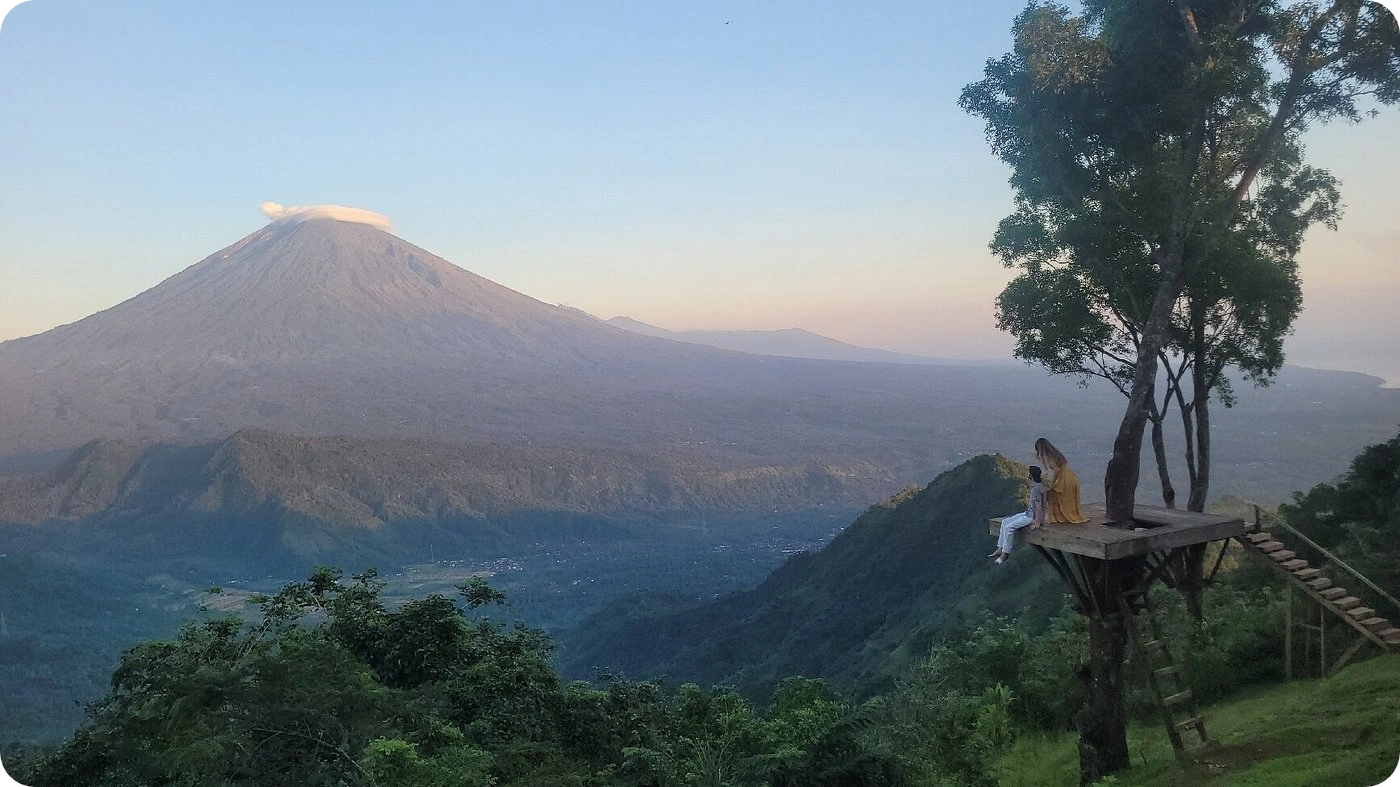
Lastly, if you’re into a serene, laid‑back, views‑focused escape, Lahangan Sweet is a tranquil highland plateau in Karangasem that delivers panoramic vistas unmatched elsewhere on the island. Perched at around 1,200 meters above sea level, it offers sweeping views of Mount Agung, verdant valleys, and the distant Bali Sea—and even Mount Rinjani on clear days. The main draw is the sunrise viewpoint, where early risers watch mist lift from the valley as golden light paints the volcano. Wooden treehouse platforms, swings, and gates offer picturesque photo opportunities, yet the setting remains peaceful and uncluttered. The drive up from Amed or Ubud takes 2–3 hours, followed by a short 800‑meter uphill walk to reach the ridge. Despite its growing popularity, Lahangan Sweet retains a calm atmosphere, making it ideal for relaxing, reflecting, or simply soaking in Bali’s highland beauty.
- Location: Banjar Dinas Gulinten, Bunutan Village, Abang District, Karangasem Regency, Bali
- Entrance Fee: IDR 30,000 for foreigners, IDR 15,000 for locals; parking fees apply (motorbike IDR 2,000; car IDR 5,000)
- Opening Hours: Daily from 06:00 to 20:00
Tips for Discovering Bali’s Hidden Gems Safely and Respectfully
Travel During Off-Peak Times
Many hidden gems are best visited in the early morning or during the shoulder seasons (April to June and September to early November). This not only helps avoid crowds but also enhances your experience with better lighting and weather conditions.
Navigate with Offline Maps and Local Advice
Apps like Maps.me and Google Maps (with saved offline areas) are essential tools for reaching obscure destinations. However, talking to local guides or homestay hosts often yields better insights than any app. In rural areas, signage can be limited, so local knowledge becomes invaluable.
Transportation Matters
For maximum flexibility, renting a scooter is the most economical way to explore hidden spots. However, for comfort and safety, especially in mountainous regions or long-distance trips, hiring a private driver or guide is recommended. They often know alternate routes and may introduce you to places not listed online.
Respect the Culture and the Environment
Many hidden attractions are located on sacred grounds or within village territories. Dress modestly when visiting temples, ask permission before entering traditional compounds, and avoid disturbing ceremonies. Carry reusable water bottles and avoid single-use plastics. Respecting local customs ensures these hidden places remain unspoiled for future visitors.
Pack for the Unexpected
Exploring lesser-known spots often involves uneven terrain, river crossings, or steep paths. Good walking shoes, reef shoes, a sarong, drinking water, and snacks are essential. Cell service may be limited in remote areas, so it’s wise to share your itinerary with someone if heading off alone.
No Taxes, No Hassle: COCO Handles Everything for Your Property
Let COCO Development Group take the stress out of property ownership. From accounting to tax optimization and payments, we handle every detail, so you enjoy hassle-free profits straight to your account.
FAQ
Yes, many are safe for solo travel, especially during daylight hours. Always inform someone of your plans, bring adequate supplies, and check local advice on weather or trail conditions.
Use updated travel blogs, offline maps, and local recommendations. While apps are helpful, speaking to locals often leads to more authentic experiences.
Some are family-friendly (e.g., Jatiluwih Rice Terraces, Penglipuran Village), but others, like Beji Guwang or Kelingking Beach’s steep trails, may not be ideal for young children or those with mobility concerns.
Renting a scooter is the most cost-effective option, but hiring a local driver offers added safety and convenience. Tours focused on eco or cultural themes can also provide curated access to hidden gems.
Absolutely. Many attractions are free or charge minimal entrance fees. Staying in guesthouses or homestays in rural areas can also help reduce costs while offering cultural immersion.
Go Where the Crowds Don’t
Bali’s most treasured experiences often lie far from the well-trodden tourist trail. From secluded waterfalls and secret canyons to quiet temples and traditional villages, the island’s hidden gems offer a deeper connection to its culture, nature, and spirit. Exploring these places requires curiosity, respect, and a bit of adventure, but the reward is an authentic, unfiltered view of Bali’s soul.
As the island evolves under the pressure of mass tourism, choosing to discover its lesser-known corners helps preserve its magic and supports local communities. Whether you’re a seasoned traveler or visiting for the first time, don’t hesitate to step off the path and embrace the quiet wonders that await.
Have you uncovered a hidden gem in Bali? Share your experiences or ask questions in the comments below. Let this guide be the start of your journey into the heart of Bali’s best-kept secrets.

Rasmus Holst is a serial entrepreneur and Co-Founder of COCO Development Group, where he helps drive innovation and growth through strategic business development. He is also the Co-Founder of Estate of Bali and Regnskabshelten.dk, Denmark’s fastest-growing accounting firm, which grew to 35 employees and generated $2.5M in turnover in 2023. Rasmus is passionate about building businesses that create long-term value and impact.











